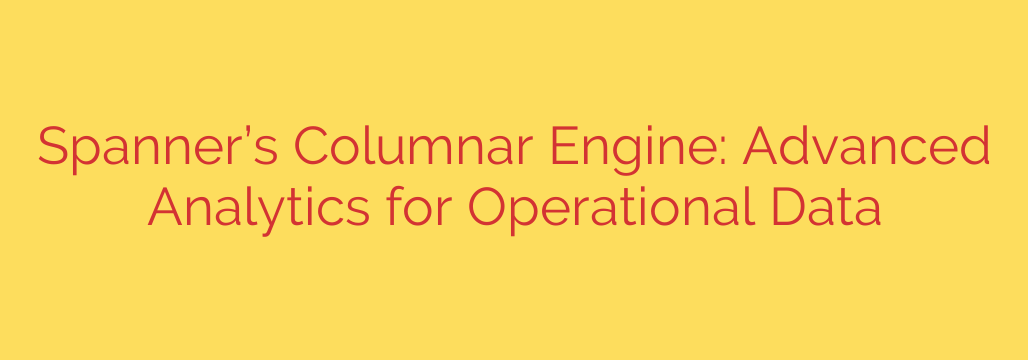
Unlocking Real-Time Insights: The Power of Running Analytics on Operational Data
For decades, a fundamental divide has shaped data architecture: transactional databases for running the business and analytical warehouses for understanding it. Businesses rely on Online Transactional Processing (OLTP) databases to handle high-throughput, mission-critical operations like e-commerce checkouts, financial trades, and inventory updates. These systems are optimized for fast reads and writes of individual records.
On the other side, Online Analytical Processing (OLAP) systems, or data warehouses, are built to analyze massive volumes of historical data to uncover trends, generate reports, and power business intelligence.
The bridge between these two worlds has always been a complex, costly, and slow process known as ETL (Extract, Transform, Load). Data is periodically copied from the transactional database to the analytical warehouse, meaning your “insights” are often based on data that is hours, or even days, old. This delay is a significant barrier in a world that now demands instant decision-making.
But what if you could eliminate that delay? Imagine running powerful analytical queries directly on your live, operational database without compromising the performance of your daily transactions. This transformative approach, known as Hybrid Transactional/Analytical Processing (HTAP), is revolutionizing how businesses use data.
The Challenge with Traditional Analytics
The core problem with the separated approach is data latency. By the time data is moved and prepared for analysis, opportunities can be missed. For example:
- A retail business can’t adjust pricing in real-time based on a sudden surge in demand.
- A financial service might detect a fraudulent transaction pattern minutes too late.
- A logistics company can’t immediately reroute shipments in response to an unexpected supply chain disruption.
To overcome this, organizations have been forced to maintain two separate, expensive systems, requiring specialized teams to manage the fragile ETL pipelines that connect them.
A New Paradigm: Bringing Analytics to Live Data
Modern database technology is now collapsing this divide by integrating a high-performance columnar analytics engine directly alongside the traditional row-based transactional engine. This means both OLTP and OLAP workloads can run on the same database, using the same data, at the same time.
Here’s why this changes everything:
Achieve True Real-Time Analytics: By querying the operational data directly, you get insights with zero latency. You are analyzing what is happening right now, not what happened yesterday. This enables immediate action, from personalizing a user’s web experience on the fly to preventing fraud as it happens.
Simplify Your Data Architecture: Say goodbye to complex and brittle ETL pipelines. A unified HTAP system means no more data duplication and no need to move data between systems for analysis. This drastically reduces architectural complexity, lowers maintenance overhead, and eliminates a common point of failure.
Boost Performance Without Compromise: A primary concern with running analytics on an operational database is performance interference. Heavy analytical queries could potentially slow down critical user-facing transactions. Advanced HTAP solutions solve this by isolating workloads. Analytical queries are handled by a dedicated columnar engine with its own processing resources, ensuring that transactional performance remains fast and predictable.
Unlock New Use Cases and Drive Efficiency: The ability to analyze live data opens up a world of possibilities that were previously impractical.
- Real-Time Fraud Detection: Analyze transaction patterns the moment they occur to block suspicious activity instantly.
- Live Inventory Management: Optimize supply chains by analyzing sales and inventory data in real-time to prevent stockouts or overstock situations.
- Dynamic Personalization: Tailor user experiences, recommendations, and offers based on their immediate actions on a website or app.
How Columnar Storage Makes It Possible
The secret to this high-performance analytical capability lies in columnar data storage. Traditional OLTP databases store data in rows, which is efficient for retrieving all the information about a single entity (like one customer’s entire profile).
However, analytical queries rarely need all the data in a row. They typically aggregate data from a few specific columns, like “summing up all sales in the ‘North America’ region.” A columnar engine stores all the data for a single column together. This means an analytical query only needs to read the specific columns it needs—’sales amount’ and ‘region’—instead of scanning through every single row of data. This dramatically reduces the amount of data processed and accelerates query speeds by orders of magnitude.
The Future is Unified
The separation between transactional and analytical systems is becoming a relic of the past. By leveraging a unified database capable of both, businesses can build simpler, more cost-effective, and vastly more powerful data platforms. The ability to act on insights derived from up-to-the-second data is no longer a luxury—it’s a critical competitive advantage. Adopting a real-time operational analytics strategy is a foundational step for any organization looking to become truly data-driven.
Source: https://cloud.google.com/blog/products/databases/spanners-columnar-engine-unites-oltp-and-analytics/








